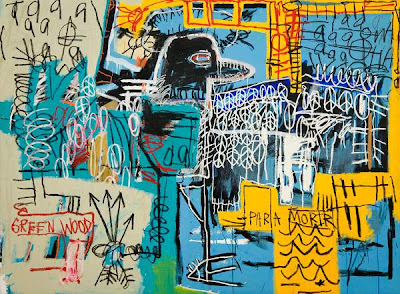For once, I arrived "early" on the bus (oh I dream of the day I can take the much more $$ train!) at 8:15 PM. So we were able to do dinner at this darling Belgian resto, Dr. Granville Moore's, who, according to their website, pumps out over 1,200 pounds of mussels and 1,400 pounds of potatoes every week! The wait was insane (2+ hours) and the hostess most certainly didn't have the mostest in terms of positive attitude, but the beer was fabulous (all Belgians) and the mussels were worth the wait. I had the Mostard Moules e Frites with the chili mayo side. YUM. The hefty Belgian ABV numbers left us sated and toasty and ready for bed and the next day to come.
 |
| "Bird on Money" by Jean-Michel Basquiat. Courtesy of 30 Americans Exhibit. |
While slightly slow to get going the next morning (it might have had to do with the wine we had for dessert), we still made the most of our Saturday. One of our stops was at the Corcoran Gallery of Art to catch the last day of "30 Americans." The show highlighted 31 African American artists that have made significant contributions to the art world. A large majority of the art was quite contemporary, which is not typically my style, but I really did enjoy seeing Glenn Ligon and Jean-Michel Basquiat.
Ligon, who we saw here at The Whitney Museum last year, is known for his practice of "intertextuality", the weaving of words and phrases into new messages within art pieces. The other piece that caught my eye (pictured above) was by Jean-Michel Basquiat, who tragically died at only 28-years old, but left us with not only his artistic legacy but also his musical legacy.
The other highlight of my trip was the visit to the Smithsonian's American History Museum where we saw two intriguing exhibits. The first was entitled "Slavery at Jefferson's Monticello: Paradox of Liberty", which explored slavery through the context of Jefferson's Virginia estate, Monticello. A President who authored the Declaration of Independence and who was opposed (albeit conflicted on the debate) to the concept of slavery, Jefferson employed over 600 slaves during his life at Monticello. Through the exhibit you learn who these slaves were, how the lived, what became of them after Jefferson's death, and their historical places in and imprints on society.
The second exhibit that we capitalized on seeing at the American History Museum was "The Star-Spangled Banner: The Flag that Inspired the National Anthem." For anyone who has seen my photography or knows me, I have a weird obsession with flags, especially the American Flag. So this was fortuitously SO up my alley! The two stars of this show were the the actual flag flown at the Battle of Baltimore in the War of 1812 and the technology. The flag is preserved in a very low-light, climate controlled room, and only observable through a pane of glass. Years of exposure to light and other elements have greatly deteriorated the flag, but it's enormity (30 ft x 34 ft) and its 15 stars pocked by bullets is an exceptional site to see and the obvious inspiration for our National Anthem. Once past the flag, you encounter a large, tactile panel that has a scrolling, life-sized image of the flag. The panel is interactive and you can touch on highlighted parts of the flag and learn about certain marks on the flag, the preservation techniques, and other facts. All Mac produced...thank you Steve Jobs.
An ironic - and bittersweet - end to the exhibit and to my DC visit was a photo montage at the end of the show. It highlighted famous moments for the flag and for the singing of the "Star-Spangled Banner." One of the most highly acclaimed performances was in 1991 when Whitney Houston sang the National Anthem at the Super Bowl. She'd passed away that morning, February 12, 2012.
